Organisational Behaviour: RPL Industries and M&M Analysis
VerifiedAdded on 2022/01/18
|33
|12522
|79
Report
AI Summary
This report delves into the multifaceted aspects of organizational behaviour, exploring the influence of culture, power dynamics, and political landscapes on individual and team performance within organizations. It examines various organizational cultures, including power, role, person, and task cultures, and their effects on employee behaviour and productivity. The report critically analyzes the impact of organizational politics, highlighting its potential to demotivate employees and disrupt workplace relationships. Furthermore, it explores different types of organizational power, such as legitimate, coercive, and expert power, and their roles in shaping employee engagement and compliance. The report provides a comparative analysis of RPL Industries and M&M, assessing the application of motivation theories, leadership styles, and team development concepts within these companies. It also offers recommendations for fostering effective teams and achieving organizational goals, emphasizing the importance of open communication, shared goals, and a supportive work environment. The report concludes with a critical analysis of the relevance of team development theories in organizational behaviour, providing valuable insights into creating dynamic and cooperative work environments.

Unit No: 12
Unit Name: Organisational Behaviour
Organizational
Behavior
Impact of organisational culture, power & politics and the role the
individuals and team play on the organisational outcome.
Keerthanambari Gopinath
Pearson BTEC Level 5 HND in Business
Regd No:
Unit Name: Organisational Behaviour
Organizational
Behavior
Impact of organisational culture, power & politics and the role the
individuals and team play on the organisational outcome.
Keerthanambari Gopinath
Pearson BTEC Level 5 HND in Business
Regd No:
Paraphrase This Document
Need a fresh take? Get an instant paraphrase of this document with our AI Paraphraser

Unit No: 12
Unit Name: Organisational Behaviour
Contents
Influence of different factors on organizational behaviour and performance..........................3
Critical analysis culture, politics and power on the influence on RPL industries and M&M
company.....................................................................................................................................7
Comparison of RPL industries and M&M company on individual and team performance...8
Effective goal achievement with content and process theories of motivation.........................9
Intrinsic and Extrinsic motivation.........................................................................................11
(Google, 2018)......................................................................................................................11
Theories of motivation.........................................................................................................11
Motivation techniques.........................................................................................................19
Application of motivation theories, concepts and models on behaviour...........................20
Justified recommendations for RPL industries........................................................................21
Effective team vs Ineffective team...........................................................................................22
Open communication:..........................................................................................................22
Establish a common goal:....................................................................................................22
Showcase diversity:..............................................................................................................23
Operate a safe environment:...............................................................................................23
Together solve problems:....................................................................................................23
Constant performance check:..............................................................................................23
Lack of openness and trust:.................................................................................................24
Conformity and mind protection:........................................................................................24
Unclear role definition:........................................................................................................24
Negative tolerance in diversity:...........................................................................................24
Lack of support:....................................................................................................................24
Team and group development theories on the development of dynamic cooperation.........25
Application of concepts and philosophies in an organizational context and it’s influence on
positive and negative behaviour..............................................................................................27
Path Goal Leadership Theory...............................................................................................27
Theory of Social Capital........................................................................................................27
The theory of contingency...................................................................................................28
Critical analysis of relevance of team development theories in organisational behaviour....30
Bibliography.............................................................................................................................31
Keerthanambari Gopinath
Pearson BTEC Level 5 HND in Business
Regd No:
Unit Name: Organisational Behaviour
Contents
Influence of different factors on organizational behaviour and performance..........................3
Critical analysis culture, politics and power on the influence on RPL industries and M&M
company.....................................................................................................................................7
Comparison of RPL industries and M&M company on individual and team performance...8
Effective goal achievement with content and process theories of motivation.........................9
Intrinsic and Extrinsic motivation.........................................................................................11
(Google, 2018)......................................................................................................................11
Theories of motivation.........................................................................................................11
Motivation techniques.........................................................................................................19
Application of motivation theories, concepts and models on behaviour...........................20
Justified recommendations for RPL industries........................................................................21
Effective team vs Ineffective team...........................................................................................22
Open communication:..........................................................................................................22
Establish a common goal:....................................................................................................22
Showcase diversity:..............................................................................................................23
Operate a safe environment:...............................................................................................23
Together solve problems:....................................................................................................23
Constant performance check:..............................................................................................23
Lack of openness and trust:.................................................................................................24
Conformity and mind protection:........................................................................................24
Unclear role definition:........................................................................................................24
Negative tolerance in diversity:...........................................................................................24
Lack of support:....................................................................................................................24
Team and group development theories on the development of dynamic cooperation.........25
Application of concepts and philosophies in an organizational context and it’s influence on
positive and negative behaviour..............................................................................................27
Path Goal Leadership Theory...............................................................................................27
Theory of Social Capital........................................................................................................27
The theory of contingency...................................................................................................28
Critical analysis of relevance of team development theories in organisational behaviour....30
Bibliography.............................................................................................................................31
Keerthanambari Gopinath
Pearson BTEC Level 5 HND in Business
Regd No:
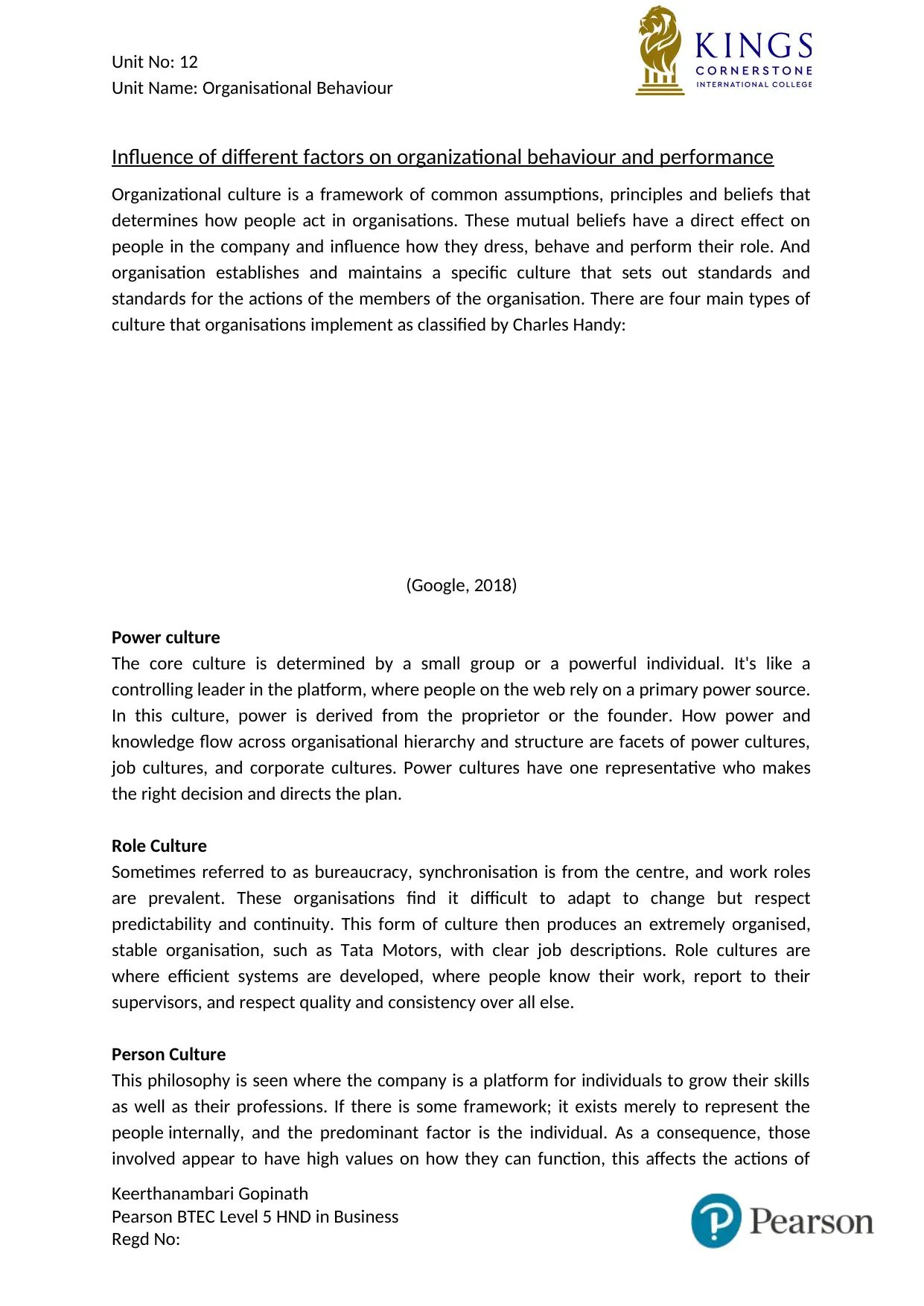
Unit No: 12
Unit Name: Organisational Behaviour
Influence of different factors on organizational behaviour and performance
Organizational culture is a framework of common assumptions, principles and beliefs that
determines how people act in organisations. These mutual beliefs have a direct effect on
people in the company and influence how they dress, behave and perform their role. And
organisation establishes and maintains a specific culture that sets out standards and
standards for the actions of the members of the organisation. There are four main types of
culture that organisations implement as classified by Charles Handy:
(Google, 2018)
Power culture
The core culture is determined by a small group or a powerful individual. It's like a
controlling leader in the platform, where people on the web rely on a primary power source.
In this culture, power is derived from the proprietor or the founder. How power and
knowledge flow across organisational hierarchy and structure are facets of power cultures,
job cultures, and corporate cultures. Power cultures have one representative who makes
the right decision and directs the plan.
Role Culture
Sometimes referred to as bureaucracy, synchronisation is from the centre, and work roles
are prevalent. These organisations find it difficult to adapt to change but respect
predictability and continuity. This form of culture then produces an extremely organised,
stable organisation, such as Tata Motors, with clear job descriptions. Role cultures are
where efficient systems are developed, where people know their work, report to their
supervisors, and respect quality and consistency over all else.
Person Culture
This philosophy is seen where the company is a platform for individuals to grow their skills
as well as their professions. If there is some framework; it exists merely to represent the
people internally, and the predominant factor is the individual. As a consequence, those
involved appear to have high values on how they can function, this affects the actions of
Keerthanambari Gopinath
Pearson BTEC Level 5 HND in Business
Regd No:
Unit Name: Organisational Behaviour
Influence of different factors on organizational behaviour and performance
Organizational culture is a framework of common assumptions, principles and beliefs that
determines how people act in organisations. These mutual beliefs have a direct effect on
people in the company and influence how they dress, behave and perform their role. And
organisation establishes and maintains a specific culture that sets out standards and
standards for the actions of the members of the organisation. There are four main types of
culture that organisations implement as classified by Charles Handy:
(Google, 2018)
Power culture
The core culture is determined by a small group or a powerful individual. It's like a
controlling leader in the platform, where people on the web rely on a primary power source.
In this culture, power is derived from the proprietor or the founder. How power and
knowledge flow across organisational hierarchy and structure are facets of power cultures,
job cultures, and corporate cultures. Power cultures have one representative who makes
the right decision and directs the plan.
Role Culture
Sometimes referred to as bureaucracy, synchronisation is from the centre, and work roles
are prevalent. These organisations find it difficult to adapt to change but respect
predictability and continuity. This form of culture then produces an extremely organised,
stable organisation, such as Tata Motors, with clear job descriptions. Role cultures are
where efficient systems are developed, where people know their work, report to their
supervisors, and respect quality and consistency over all else.
Person Culture
This philosophy is seen where the company is a platform for individuals to grow their skills
as well as their professions. If there is some framework; it exists merely to represent the
people internally, and the predominant factor is the individual. As a consequence, those
involved appear to have high values on how they can function, this affects the actions of
Keerthanambari Gopinath
Pearson BTEC Level 5 HND in Business
Regd No:
⊘ This is a preview!⊘
Do you want full access?
Subscribe today to unlock all pages.

Trusted by 1+ million students worldwide
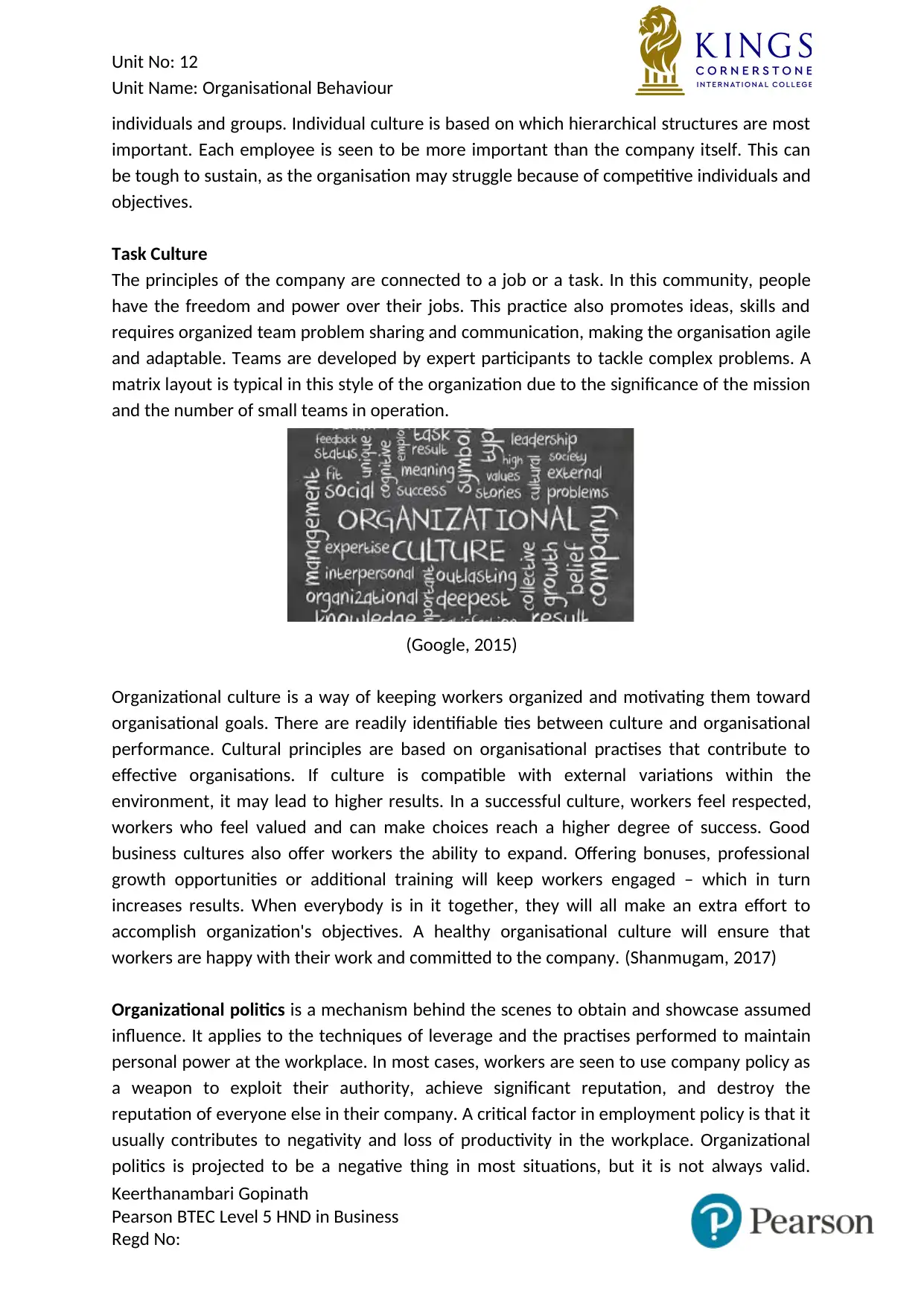
Unit No: 12
Unit Name: Organisational Behaviour
individuals and groups. Individual culture is based on which hierarchical structures are most
important. Each employee is seen to be more important than the company itself. This can
be tough to sustain, as the organisation may struggle because of competitive individuals and
objectives.
Task Culture
The principles of the company are connected to a job or a task. In this community, people
have the freedom and power over their jobs. This practice also promotes ideas, skills and
requires organized team problem sharing and communication, making the organisation agile
and adaptable. Teams are developed by expert participants to tackle complex problems. A
matrix layout is typical in this style of the organization due to the significance of the mission
and the number of small teams in operation.
(Google, 2015)
Organizational culture is a way of keeping workers organized and motivating them toward
organisational goals. There are readily identifiable ties between culture and organisational
performance. Cultural principles are based on organisational practises that contribute to
effective organisations. If culture is compatible with external variations within the
environment, it may lead to higher results. In a successful culture, workers feel respected,
workers who feel valued and can make choices reach a higher degree of success. Good
business cultures also offer workers the ability to expand. Offering bonuses, professional
growth opportunities or additional training will keep workers engaged – which in turn
increases results. When everybody is in it together, they will all make an extra effort to
accomplish organization's objectives. A healthy organisational culture will ensure that
workers are happy with their work and committed to the company. (Shanmugam, 2017)
Organizational politics is a mechanism behind the scenes to obtain and showcase assumed
influence. It applies to the techniques of leverage and the practises performed to maintain
personal power at the workplace. In most cases, workers are seen to use company policy as
a weapon to exploit their authority, achieve significant reputation, and destroy the
reputation of everyone else in their company. A critical factor in employment policy is that it
usually contributes to negativity and loss of productivity in the workplace. Organizational
politics is projected to be a negative thing in most situations, but it is not always valid.
Keerthanambari Gopinath
Pearson BTEC Level 5 HND in Business
Regd No:
Unit Name: Organisational Behaviour
individuals and groups. Individual culture is based on which hierarchical structures are most
important. Each employee is seen to be more important than the company itself. This can
be tough to sustain, as the organisation may struggle because of competitive individuals and
objectives.
Task Culture
The principles of the company are connected to a job or a task. In this community, people
have the freedom and power over their jobs. This practice also promotes ideas, skills and
requires organized team problem sharing and communication, making the organisation agile
and adaptable. Teams are developed by expert participants to tackle complex problems. A
matrix layout is typical in this style of the organization due to the significance of the mission
and the number of small teams in operation.
(Google, 2015)
Organizational culture is a way of keeping workers organized and motivating them toward
organisational goals. There are readily identifiable ties between culture and organisational
performance. Cultural principles are based on organisational practises that contribute to
effective organisations. If culture is compatible with external variations within the
environment, it may lead to higher results. In a successful culture, workers feel respected,
workers who feel valued and can make choices reach a higher degree of success. Good
business cultures also offer workers the ability to expand. Offering bonuses, professional
growth opportunities or additional training will keep workers engaged – which in turn
increases results. When everybody is in it together, they will all make an extra effort to
accomplish organization's objectives. A healthy organisational culture will ensure that
workers are happy with their work and committed to the company. (Shanmugam, 2017)
Organizational politics is a mechanism behind the scenes to obtain and showcase assumed
influence. It applies to the techniques of leverage and the practises performed to maintain
personal power at the workplace. In most cases, workers are seen to use company policy as
a weapon to exploit their authority, achieve significant reputation, and destroy the
reputation of everyone else in their company. A critical factor in employment policy is that it
usually contributes to negativity and loss of productivity in the workplace. Organizational
politics is projected to be a negative thing in most situations, but it is not always valid.
Keerthanambari Gopinath
Pearson BTEC Level 5 HND in Business
Regd No:
Paraphrase This Document
Need a fresh take? Get an instant paraphrase of this document with our AI Paraphraser
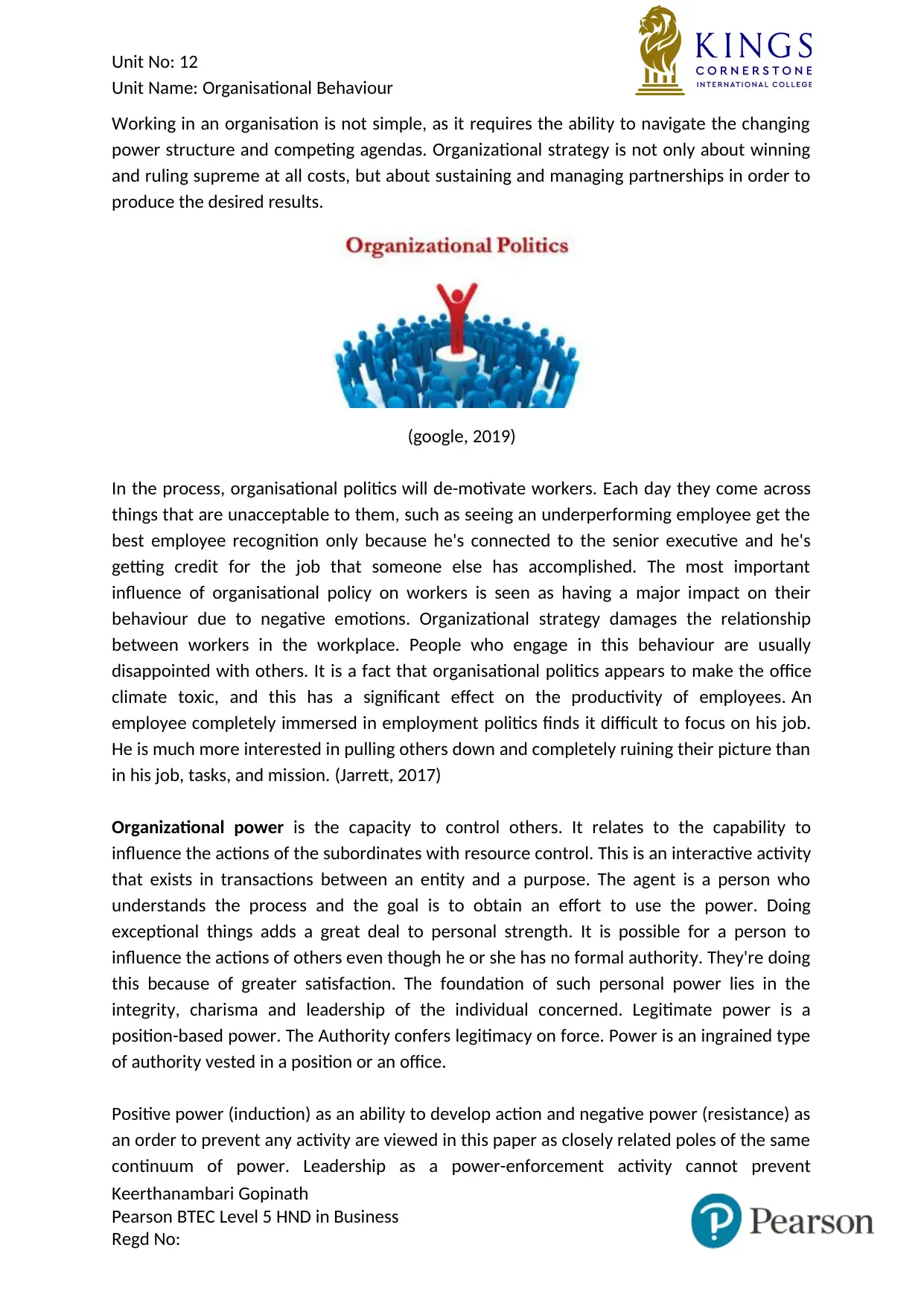
Unit No: 12
Unit Name: Organisational Behaviour
Working in an organisation is not simple, as it requires the ability to navigate the changing
power structure and competing agendas. Organizational strategy is not only about winning
and ruling supreme at all costs, but about sustaining and managing partnerships in order to
produce the desired results.
(google, 2019)
In the process, organisational politics will de-motivate workers. Each day they come across
things that are unacceptable to them, such as seeing an underperforming employee get the
best employee recognition only because he's connected to the senior executive and he's
getting credit for the job that someone else has accomplished. The most important
influence of organisational policy on workers is seen as having a major impact on their
behaviour due to negative emotions. Organizational strategy damages the relationship
between workers in the workplace. People who engage in this behaviour are usually
disappointed with others. It is a fact that organisational politics appears to make the office
climate toxic, and this has a significant effect on the productivity of employees. An
employee completely immersed in employment politics finds it difficult to focus on his job.
He is much more interested in pulling others down and completely ruining their picture than
in his job, tasks, and mission. (Jarrett, 2017)
Organizational power is the capacity to control others. It relates to the capability to
influence the actions of the subordinates with resource control. This is an interactive activity
that exists in transactions between an entity and a purpose. The agent is a person who
understands the process and the goal is to obtain an effort to use the power. Doing
exceptional things adds a great deal to personal strength. It is possible for a person to
influence the actions of others even though he or she has no formal authority. They're doing
this because of greater satisfaction. The foundation of such personal power lies in the
integrity, charisma and leadership of the individual concerned. Legitimate power is a
position-based power. The Authority confers legitimacy on force. Power is an ingrained type
of authority vested in a position or an office.
Positive power (induction) as an ability to develop action and negative power (resistance) as
an order to prevent any activity are viewed in this paper as closely related poles of the same
continuum of power. Leadership as a power-enforcement activity cannot prevent
Keerthanambari Gopinath
Pearson BTEC Level 5 HND in Business
Regd No:
Unit Name: Organisational Behaviour
Working in an organisation is not simple, as it requires the ability to navigate the changing
power structure and competing agendas. Organizational strategy is not only about winning
and ruling supreme at all costs, but about sustaining and managing partnerships in order to
produce the desired results.
(google, 2019)
In the process, organisational politics will de-motivate workers. Each day they come across
things that are unacceptable to them, such as seeing an underperforming employee get the
best employee recognition only because he's connected to the senior executive and he's
getting credit for the job that someone else has accomplished. The most important
influence of organisational policy on workers is seen as having a major impact on their
behaviour due to negative emotions. Organizational strategy damages the relationship
between workers in the workplace. People who engage in this behaviour are usually
disappointed with others. It is a fact that organisational politics appears to make the office
climate toxic, and this has a significant effect on the productivity of employees. An
employee completely immersed in employment politics finds it difficult to focus on his job.
He is much more interested in pulling others down and completely ruining their picture than
in his job, tasks, and mission. (Jarrett, 2017)
Organizational power is the capacity to control others. It relates to the capability to
influence the actions of the subordinates with resource control. This is an interactive activity
that exists in transactions between an entity and a purpose. The agent is a person who
understands the process and the goal is to obtain an effort to use the power. Doing
exceptional things adds a great deal to personal strength. It is possible for a person to
influence the actions of others even though he or she has no formal authority. They're doing
this because of greater satisfaction. The foundation of such personal power lies in the
integrity, charisma and leadership of the individual concerned. Legitimate power is a
position-based power. The Authority confers legitimacy on force. Power is an ingrained type
of authority vested in a position or an office.
Positive power (induction) as an ability to develop action and negative power (resistance) as
an order to prevent any activity are viewed in this paper as closely related poles of the same
continuum of power. Leadership as a power-enforcement activity cannot prevent
Keerthanambari Gopinath
Pearson BTEC Level 5 HND in Business
Regd No:
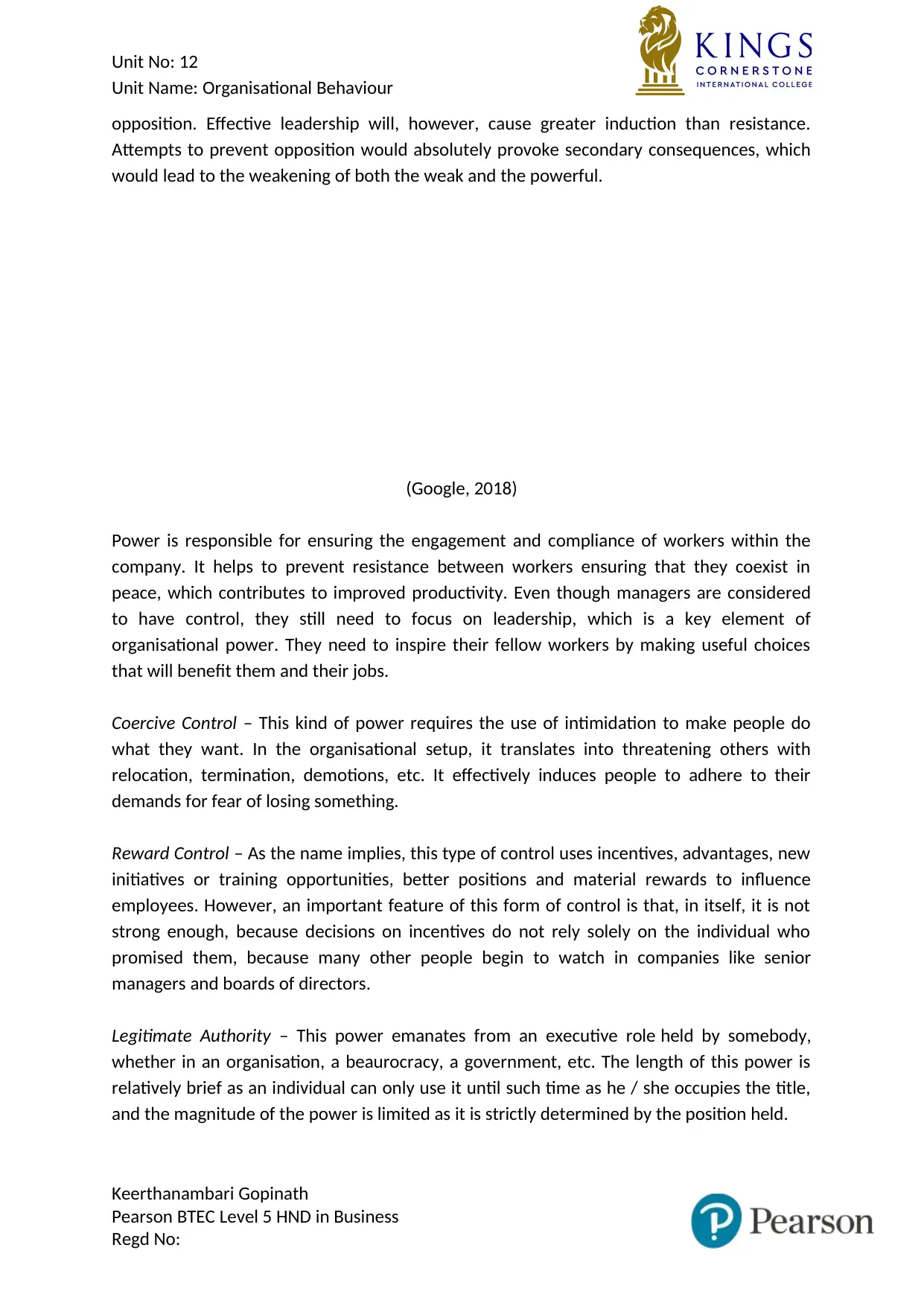
Unit No: 12
Unit Name: Organisational Behaviour
opposition. Effective leadership will, however, cause greater induction than resistance.
Attempts to prevent opposition would absolutely provoke secondary consequences, which
would lead to the weakening of both the weak and the powerful.
(Google, 2018)
Power is responsible for ensuring the engagement and compliance of workers within the
company. It helps to prevent resistance between workers ensuring that they coexist in
peace, which contributes to improved productivity. Even though managers are considered
to have control, they still need to focus on leadership, which is a key element of
organisational power. They need to inspire their fellow workers by making useful choices
that will benefit them and their jobs.
Coercive Control – This kind of power requires the use of intimidation to make people do
what they want. In the organisational setup, it translates into threatening others with
relocation, termination, demotions, etc. It effectively induces people to adhere to their
demands for fear of losing something.
Reward Control – As the name implies, this type of control uses incentives, advantages, new
initiatives or training opportunities, better positions and material rewards to influence
employees. However, an important feature of this form of control is that, in itself, it is not
strong enough, because decisions on incentives do not rely solely on the individual who
promised them, because many other people begin to watch in companies like senior
managers and boards of directors.
Legitimate Authority – This power emanates from an executive role held by somebody,
whether in an organisation, a beaurocracy, a government, etc. The length of this power is
relatively brief as an individual can only use it until such time as he / she occupies the title,
and the magnitude of the power is limited as it is strictly determined by the position held.
Keerthanambari Gopinath
Pearson BTEC Level 5 HND in Business
Regd No:
Unit Name: Organisational Behaviour
opposition. Effective leadership will, however, cause greater induction than resistance.
Attempts to prevent opposition would absolutely provoke secondary consequences, which
would lead to the weakening of both the weak and the powerful.
(Google, 2018)
Power is responsible for ensuring the engagement and compliance of workers within the
company. It helps to prevent resistance between workers ensuring that they coexist in
peace, which contributes to improved productivity. Even though managers are considered
to have control, they still need to focus on leadership, which is a key element of
organisational power. They need to inspire their fellow workers by making useful choices
that will benefit them and their jobs.
Coercive Control – This kind of power requires the use of intimidation to make people do
what they want. In the organisational setup, it translates into threatening others with
relocation, termination, demotions, etc. It effectively induces people to adhere to their
demands for fear of losing something.
Reward Control – As the name implies, this type of control uses incentives, advantages, new
initiatives or training opportunities, better positions and material rewards to influence
employees. However, an important feature of this form of control is that, in itself, it is not
strong enough, because decisions on incentives do not rely solely on the individual who
promised them, because many other people begin to watch in companies like senior
managers and boards of directors.
Legitimate Authority – This power emanates from an executive role held by somebody,
whether in an organisation, a beaurocracy, a government, etc. The length of this power is
relatively brief as an individual can only use it until such time as he / she occupies the title,
and the magnitude of the power is limited as it is strictly determined by the position held.
Keerthanambari Gopinath
Pearson BTEC Level 5 HND in Business
Regd No:
⊘ This is a preview!⊘
Do you want full access?
Subscribe today to unlock all pages.

Trusted by 1+ million students worldwide
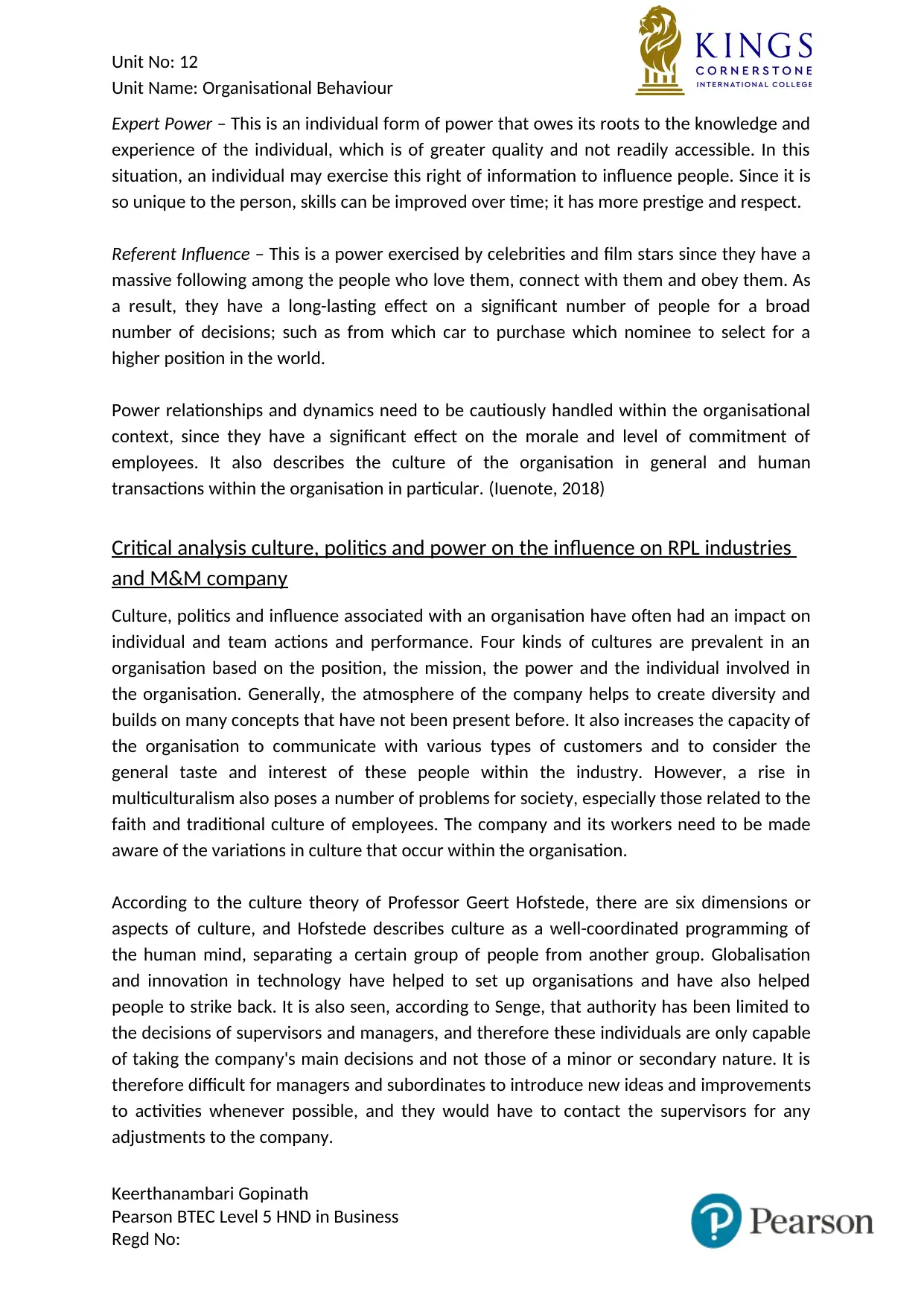
Unit No: 12
Unit Name: Organisational Behaviour
Expert Power – This is an individual form of power that owes its roots to the knowledge and
experience of the individual, which is of greater quality and not readily accessible. In this
situation, an individual may exercise this right of information to influence people. Since it is
so unique to the person, skills can be improved over time; it has more prestige and respect.
Referent Influence – This is a power exercised by celebrities and film stars since they have a
massive following among the people who love them, connect with them and obey them. As
a result, they have a long-lasting effect on a significant number of people for a broad
number of decisions; such as from which car to purchase which nominee to select for a
higher position in the world.
Power relationships and dynamics need to be cautiously handled within the organisational
context, since they have a significant effect on the morale and level of commitment of
employees. It also describes the culture of the organisation in general and human
transactions within the organisation in particular. (Iuenote, 2018)
Critical analysis culture, politics and power on the influence on RPL industries
and M&M company
Culture, politics and influence associated with an organisation have often had an impact on
individual and team actions and performance. Four kinds of cultures are prevalent in an
organisation based on the position, the mission, the power and the individual involved in
the organisation. Generally, the atmosphere of the company helps to create diversity and
builds on many concepts that have not been present before. It also increases the capacity of
the organisation to communicate with various types of customers and to consider the
general taste and interest of these people within the industry. However, a rise in
multiculturalism also poses a number of problems for society, especially those related to the
faith and traditional culture of employees. The company and its workers need to be made
aware of the variations in culture that occur within the organisation.
According to the culture theory of Professor Geert Hofstede, there are six dimensions or
aspects of culture, and Hofstede describes culture as a well-coordinated programming of
the human mind, separating a certain group of people from another group. Globalisation
and innovation in technology have helped to set up organisations and have also helped
people to strike back. It is also seen, according to Senge, that authority has been limited to
the decisions of supervisors and managers, and therefore these individuals are only capable
of taking the company's main decisions and not those of a minor or secondary nature. It is
therefore difficult for managers and subordinates to introduce new ideas and improvements
to activities whenever possible, and they would have to contact the supervisors for any
adjustments to the company.
Keerthanambari Gopinath
Pearson BTEC Level 5 HND in Business
Regd No:
Unit Name: Organisational Behaviour
Expert Power – This is an individual form of power that owes its roots to the knowledge and
experience of the individual, which is of greater quality and not readily accessible. In this
situation, an individual may exercise this right of information to influence people. Since it is
so unique to the person, skills can be improved over time; it has more prestige and respect.
Referent Influence – This is a power exercised by celebrities and film stars since they have a
massive following among the people who love them, connect with them and obey them. As
a result, they have a long-lasting effect on a significant number of people for a broad
number of decisions; such as from which car to purchase which nominee to select for a
higher position in the world.
Power relationships and dynamics need to be cautiously handled within the organisational
context, since they have a significant effect on the morale and level of commitment of
employees. It also describes the culture of the organisation in general and human
transactions within the organisation in particular. (Iuenote, 2018)
Critical analysis culture, politics and power on the influence on RPL industries
and M&M company
Culture, politics and influence associated with an organisation have often had an impact on
individual and team actions and performance. Four kinds of cultures are prevalent in an
organisation based on the position, the mission, the power and the individual involved in
the organisation. Generally, the atmosphere of the company helps to create diversity and
builds on many concepts that have not been present before. It also increases the capacity of
the organisation to communicate with various types of customers and to consider the
general taste and interest of these people within the industry. However, a rise in
multiculturalism also poses a number of problems for society, especially those related to the
faith and traditional culture of employees. The company and its workers need to be made
aware of the variations in culture that occur within the organisation.
According to the culture theory of Professor Geert Hofstede, there are six dimensions or
aspects of culture, and Hofstede describes culture as a well-coordinated programming of
the human mind, separating a certain group of people from another group. Globalisation
and innovation in technology have helped to set up organisations and have also helped
people to strike back. It is also seen, according to Senge, that authority has been limited to
the decisions of supervisors and managers, and therefore these individuals are only capable
of taking the company's main decisions and not those of a minor or secondary nature. It is
therefore difficult for managers and subordinates to introduce new ideas and improvements
to activities whenever possible, and they would have to contact the supervisors for any
adjustments to the company.
Keerthanambari Gopinath
Pearson BTEC Level 5 HND in Business
Regd No:
Paraphrase This Document
Need a fresh take? Get an instant paraphrase of this document with our AI Paraphraser

Unit No: 12
Unit Name: Organisational Behaviour
Without these rights, these people will struggle to do their job properly and will not be able
to bring in the improvements required at those stages. Politics in an enterprise has
detrimental effects, as people are engaged in shout profanities and non-cooperating with
others, thus damaging competitiveness and the positive image of the organisation. The
effect of power influences individuals and the overall success of the organisation. Control,
when used positively motivates workers and when used negatively, destroys the brand
name and the working environment. (Hofstede-insights, 2019)
RPL industries and M&M are two contrasting views of an organization and as stated in the
case study, M&M seemed to value its employee’s satisfaction and maintain an appropriate
and accepting company culture. However, RPL industries are rather biased and focus on
more the corporate reputation and bureaucratic profit rather than its workplace
environment. In looking at the case study, the main reason RPL industry is a big corporate
organization is because of its better structure but it’s not nearly as efficient and a safe
environment when compared to M&M company. The only method to alleviate the issue of
improper hierarchy in the workplace to implement a practice that M&M had practiced with
its employees in to RPL.
Comparison of RPL industries and M&M company on individual and team performance
The power structure in RPL is relatively off-balance and this may be due to the size of the
organization, where it might be more difficult to keep of each and every employee’s
performance and satisfaction in the job. RPL industries are a rather hierarchical and power-
driven organisation that lacks the ability to accommodate new and creative ideas, any
reform is fiercely resisted, egos clash and fewer resources are made available to high-
performing players, thereby restricting organisational development. Negative politics has an
effect on the concentration of staff in RPL industries. There is a possibility of making a lot of
errors when one is interested in the politics of the workplace. In most situations, the
concentration of personnel involved in organisational strategy is elsewhere. Employees
could not even produce goods and services as requested by the company. It shows that
workers whose concentration is split cannot increase the efficiency of the organisation.
On the other hand, M&M as an organization where a solid, healthy culture is developed in a
workplace where workers have higher levels of job satisfaction, stronger employee
engagement and, essentially, improved productivity. Satisfied, committed workers go
beyond what is expected of them, and they are confident in the work they perform.
Employees are happy where they work won't hesitate to let anyone know. That's why
businesses with a strong and vibrant community don't just have staff, they have wonderful
advocates for their company. But employee involvement isn't just a great thing about
recruiting. It can also have an effect on the production of revenue. Many of the workers are
eager to be champions for their business – if they have a positive experience to speak
Keerthanambari Gopinath
Pearson BTEC Level 5 HND in Business
Regd No:
Unit Name: Organisational Behaviour
Without these rights, these people will struggle to do their job properly and will not be able
to bring in the improvements required at those stages. Politics in an enterprise has
detrimental effects, as people are engaged in shout profanities and non-cooperating with
others, thus damaging competitiveness and the positive image of the organisation. The
effect of power influences individuals and the overall success of the organisation. Control,
when used positively motivates workers and when used negatively, destroys the brand
name and the working environment. (Hofstede-insights, 2019)
RPL industries and M&M are two contrasting views of an organization and as stated in the
case study, M&M seemed to value its employee’s satisfaction and maintain an appropriate
and accepting company culture. However, RPL industries are rather biased and focus on
more the corporate reputation and bureaucratic profit rather than its workplace
environment. In looking at the case study, the main reason RPL industry is a big corporate
organization is because of its better structure but it’s not nearly as efficient and a safe
environment when compared to M&M company. The only method to alleviate the issue of
improper hierarchy in the workplace to implement a practice that M&M had practiced with
its employees in to RPL.
Comparison of RPL industries and M&M company on individual and team performance
The power structure in RPL is relatively off-balance and this may be due to the size of the
organization, where it might be more difficult to keep of each and every employee’s
performance and satisfaction in the job. RPL industries are a rather hierarchical and power-
driven organisation that lacks the ability to accommodate new and creative ideas, any
reform is fiercely resisted, egos clash and fewer resources are made available to high-
performing players, thereby restricting organisational development. Negative politics has an
effect on the concentration of staff in RPL industries. There is a possibility of making a lot of
errors when one is interested in the politics of the workplace. In most situations, the
concentration of personnel involved in organisational strategy is elsewhere. Employees
could not even produce goods and services as requested by the company. It shows that
workers whose concentration is split cannot increase the efficiency of the organisation.
On the other hand, M&M as an organization where a solid, healthy culture is developed in a
workplace where workers have higher levels of job satisfaction, stronger employee
engagement and, essentially, improved productivity. Satisfied, committed workers go
beyond what is expected of them, and they are confident in the work they perform.
Employees are happy where they work won't hesitate to let anyone know. That's why
businesses with a strong and vibrant community don't just have staff, they have wonderful
advocates for their company. But employee involvement isn't just a great thing about
recruiting. It can also have an effect on the production of revenue. Many of the workers are
eager to be champions for their business – if they have a positive experience to speak
Keerthanambari Gopinath
Pearson BTEC Level 5 HND in Business
Regd No:
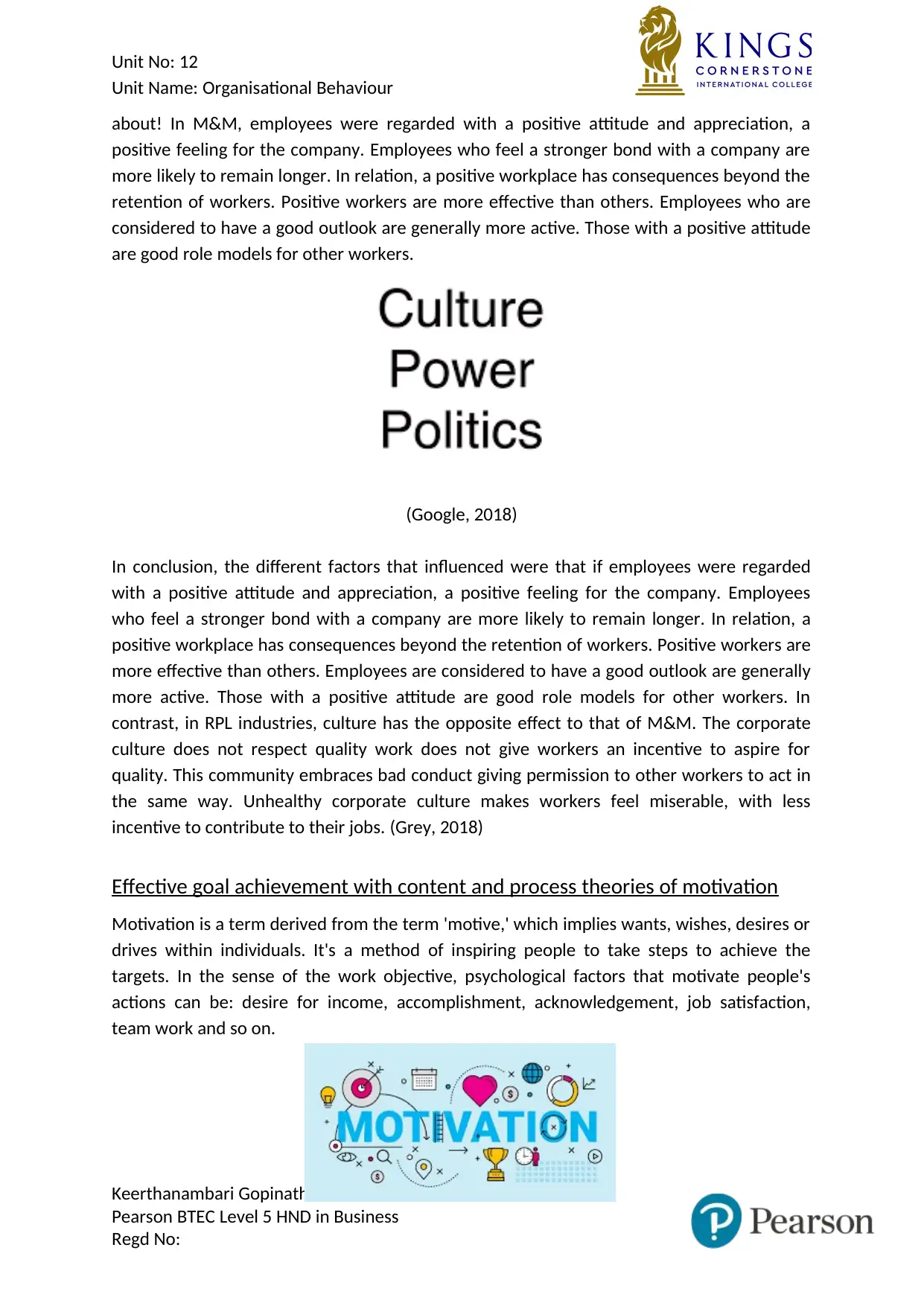
Unit No: 12
Unit Name: Organisational Behaviour
about! In M&M, employees were regarded with a positive attitude and appreciation, a
positive feeling for the company. Employees who feel a stronger bond with a company are
more likely to remain longer. In relation, a positive workplace has consequences beyond the
retention of workers. Positive workers are more effective than others. Employees who are
considered to have a good outlook are generally more active. Those with a positive attitude
are good role models for other workers.
(Google, 2018)
In conclusion, the different factors that influenced were that if employees were regarded
with a positive attitude and appreciation, a positive feeling for the company. Employees
who feel a stronger bond with a company are more likely to remain longer. In relation, a
positive workplace has consequences beyond the retention of workers. Positive workers are
more effective than others. Employees are considered to have a good outlook are generally
more active. Those with a positive attitude are good role models for other workers. In
contrast, in RPL industries, culture has the opposite effect to that of M&M. The corporate
culture does not respect quality work does not give workers an incentive to aspire for
quality. This community embraces bad conduct giving permission to other workers to act in
the same way. Unhealthy corporate culture makes workers feel miserable, with less
incentive to contribute to their jobs. (Grey, 2018)
Effective goal achievement with content and process theories of motivation
Motivation is a term derived from the term 'motive,' which implies wants, wishes, desires or
drives within individuals. It's a method of inspiring people to take steps to achieve the
targets. In the sense of the work objective, psychological factors that motivate people's
actions can be: desire for income, accomplishment, acknowledgement, job satisfaction,
team work and so on.
Keerthanambari Gopinath
Pearson BTEC Level 5 HND in Business
Regd No:
Unit Name: Organisational Behaviour
about! In M&M, employees were regarded with a positive attitude and appreciation, a
positive feeling for the company. Employees who feel a stronger bond with a company are
more likely to remain longer. In relation, a positive workplace has consequences beyond the
retention of workers. Positive workers are more effective than others. Employees who are
considered to have a good outlook are generally more active. Those with a positive attitude
are good role models for other workers.
(Google, 2018)
In conclusion, the different factors that influenced were that if employees were regarded
with a positive attitude and appreciation, a positive feeling for the company. Employees
who feel a stronger bond with a company are more likely to remain longer. In relation, a
positive workplace has consequences beyond the retention of workers. Positive workers are
more effective than others. Employees are considered to have a good outlook are generally
more active. Those with a positive attitude are good role models for other workers. In
contrast, in RPL industries, culture has the opposite effect to that of M&M. The corporate
culture does not respect quality work does not give workers an incentive to aspire for
quality. This community embraces bad conduct giving permission to other workers to act in
the same way. Unhealthy corporate culture makes workers feel miserable, with less
incentive to contribute to their jobs. (Grey, 2018)
Effective goal achievement with content and process theories of motivation
Motivation is a term derived from the term 'motive,' which implies wants, wishes, desires or
drives within individuals. It's a method of inspiring people to take steps to achieve the
targets. In the sense of the work objective, psychological factors that motivate people's
actions can be: desire for income, accomplishment, acknowledgement, job satisfaction,
team work and so on.
Keerthanambari Gopinath
Pearson BTEC Level 5 HND in Business
Regd No:
⊘ This is a preview!⊘
Do you want full access?
Subscribe today to unlock all pages.

Trusted by 1+ million students worldwide
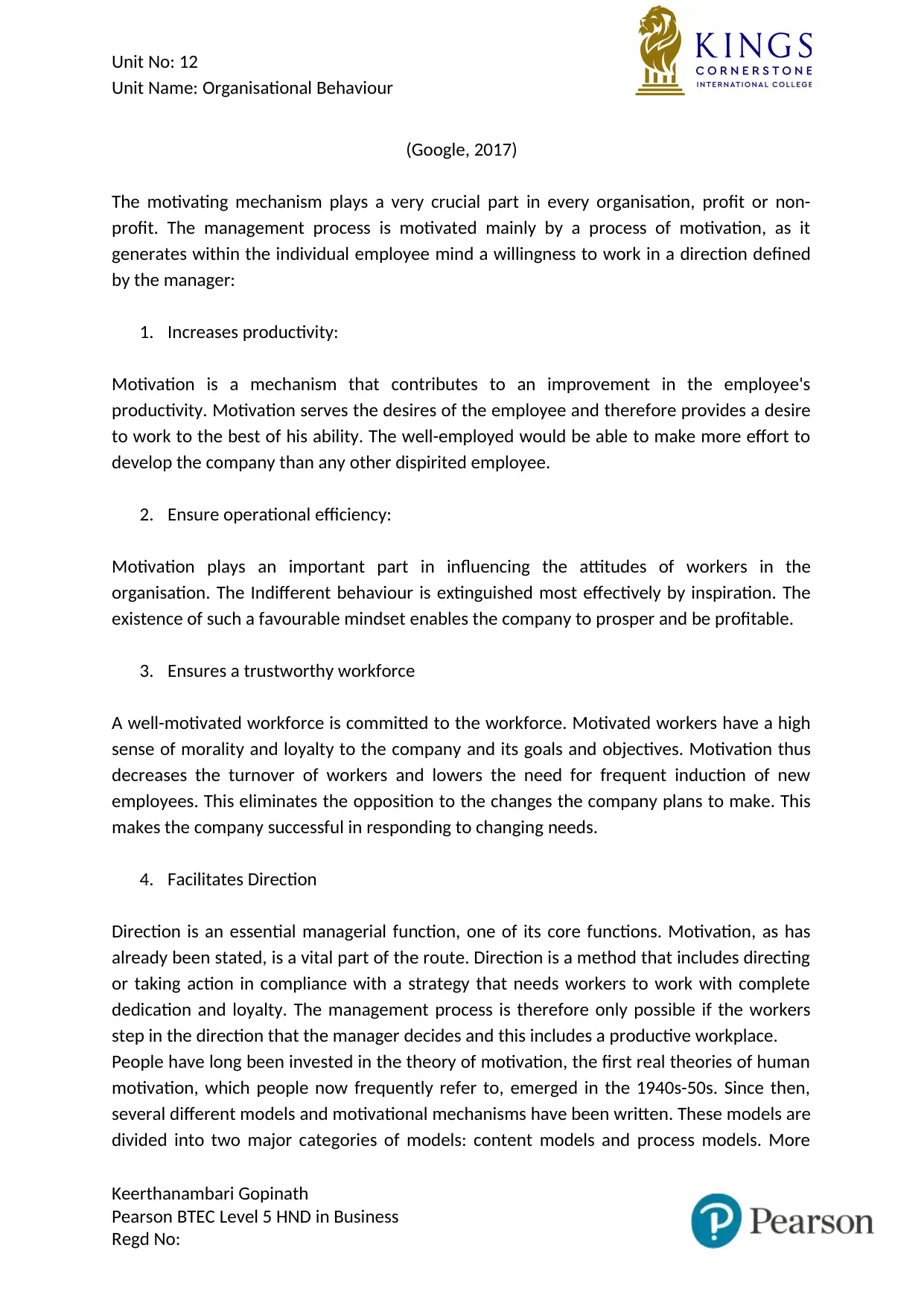
Unit No: 12
Unit Name: Organisational Behaviour
(Google, 2017)
The motivating mechanism plays a very crucial part in every organisation, profit or non-
profit. The management process is motivated mainly by a process of motivation, as it
generates within the individual employee mind a willingness to work in a direction defined
by the manager:
1. Increases productivity:
Motivation is a mechanism that contributes to an improvement in the employee's
productivity. Motivation serves the desires of the employee and therefore provides a desire
to work to the best of his ability. The well-employed would be able to make more effort to
develop the company than any other dispirited employee.
2. Ensure operational efficiency:
Motivation plays an important part in influencing the attitudes of workers in the
organisation. The Indifferent behaviour is extinguished most effectively by inspiration. The
existence of such a favourable mindset enables the company to prosper and be profitable.
3. Ensures a trustworthy workforce
A well-motivated workforce is committed to the workforce. Motivated workers have a high
sense of morality and loyalty to the company and its goals and objectives. Motivation thus
decreases the turnover of workers and lowers the need for frequent induction of new
employees. This eliminates the opposition to the changes the company plans to make. This
makes the company successful in responding to changing needs.
4. Facilitates Direction
Direction is an essential managerial function, one of its core functions. Motivation, as has
already been stated, is a vital part of the route. Direction is a method that includes directing
or taking action in compliance with a strategy that needs workers to work with complete
dedication and loyalty. The management process is therefore only possible if the workers
step in the direction that the manager decides and this includes a productive workplace.
People have long been invested in the theory of motivation, the first real theories of human
motivation, which people now frequently refer to, emerged in the 1940s-50s. Since then,
several different models and motivational mechanisms have been written. These models are
divided into two major categories of models: content models and process models. More
Keerthanambari Gopinath
Pearson BTEC Level 5 HND in Business
Regd No:
Unit Name: Organisational Behaviour
(Google, 2017)
The motivating mechanism plays a very crucial part in every organisation, profit or non-
profit. The management process is motivated mainly by a process of motivation, as it
generates within the individual employee mind a willingness to work in a direction defined
by the manager:
1. Increases productivity:
Motivation is a mechanism that contributes to an improvement in the employee's
productivity. Motivation serves the desires of the employee and therefore provides a desire
to work to the best of his ability. The well-employed would be able to make more effort to
develop the company than any other dispirited employee.
2. Ensure operational efficiency:
Motivation plays an important part in influencing the attitudes of workers in the
organisation. The Indifferent behaviour is extinguished most effectively by inspiration. The
existence of such a favourable mindset enables the company to prosper and be profitable.
3. Ensures a trustworthy workforce
A well-motivated workforce is committed to the workforce. Motivated workers have a high
sense of morality and loyalty to the company and its goals and objectives. Motivation thus
decreases the turnover of workers and lowers the need for frequent induction of new
employees. This eliminates the opposition to the changes the company plans to make. This
makes the company successful in responding to changing needs.
4. Facilitates Direction
Direction is an essential managerial function, one of its core functions. Motivation, as has
already been stated, is a vital part of the route. Direction is a method that includes directing
or taking action in compliance with a strategy that needs workers to work with complete
dedication and loyalty. The management process is therefore only possible if the workers
step in the direction that the manager decides and this includes a productive workplace.
People have long been invested in the theory of motivation, the first real theories of human
motivation, which people now frequently refer to, emerged in the 1940s-50s. Since then,
several different models and motivational mechanisms have been written. These models are
divided into two major categories of models: content models and process models. More
Keerthanambari Gopinath
Pearson BTEC Level 5 HND in Business
Regd No:
Paraphrase This Document
Need a fresh take? Get an instant paraphrase of this document with our AI Paraphraser
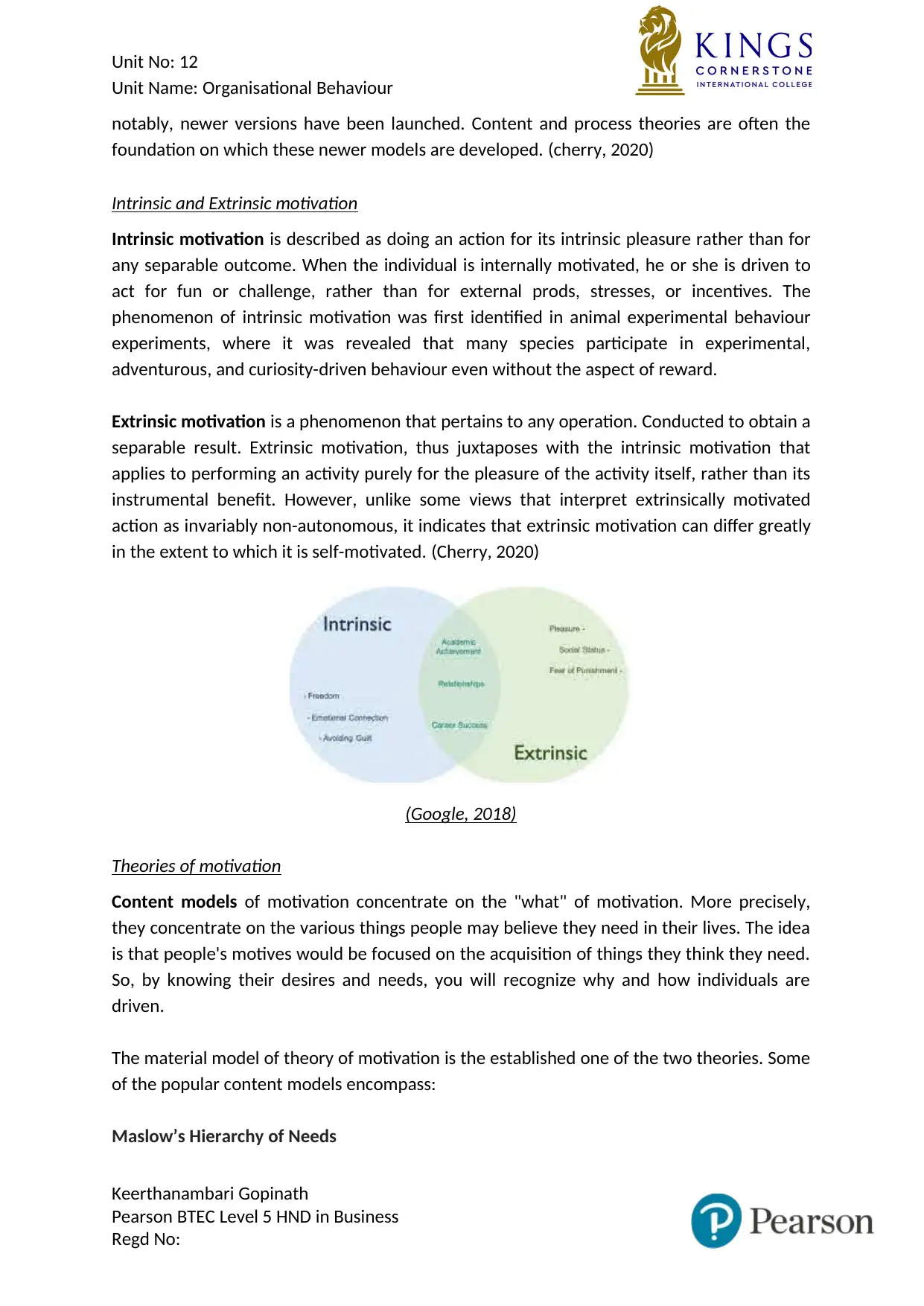
Unit No: 12
Unit Name: Organisational Behaviour
notably, newer versions have been launched. Content and process theories are often the
foundation on which these newer models are developed. (cherry, 2020)
Intrinsic and Extrinsic motivation
Intrinsic motivation is described as doing an action for its intrinsic pleasure rather than for
any separable outcome. When the individual is internally motivated, he or she is driven to
act for fun or challenge, rather than for external prods, stresses, or incentives. The
phenomenon of intrinsic motivation was first identified in animal experimental behaviour
experiments, where it was revealed that many species participate in experimental,
adventurous, and curiosity-driven behaviour even without the aspect of reward.
Extrinsic motivation is a phenomenon that pertains to any operation. Conducted to obtain a
separable result. Extrinsic motivation, thus juxtaposes with the intrinsic motivation that
applies to performing an activity purely for the pleasure of the activity itself, rather than its
instrumental benefit. However, unlike some views that interpret extrinsically motivated
action as invariably non-autonomous, it indicates that extrinsic motivation can differ greatly
in the extent to which it is self-motivated. (Cherry, 2020)
(Google, 2018)
Theories of motivation
Content models of motivation concentrate on the "what" of motivation. More precisely,
they concentrate on the various things people may believe they need in their lives. The idea
is that people's motives would be focused on the acquisition of things they think they need.
So, by knowing their desires and needs, you will recognize why and how individuals are
driven.
The material model of theory of motivation is the established one of the two theories. Some
of the popular content models encompass:
Maslow’s Hierarchy of Needs
Keerthanambari Gopinath
Pearson BTEC Level 5 HND in Business
Regd No:
Unit Name: Organisational Behaviour
notably, newer versions have been launched. Content and process theories are often the
foundation on which these newer models are developed. (cherry, 2020)
Intrinsic and Extrinsic motivation
Intrinsic motivation is described as doing an action for its intrinsic pleasure rather than for
any separable outcome. When the individual is internally motivated, he or she is driven to
act for fun or challenge, rather than for external prods, stresses, or incentives. The
phenomenon of intrinsic motivation was first identified in animal experimental behaviour
experiments, where it was revealed that many species participate in experimental,
adventurous, and curiosity-driven behaviour even without the aspect of reward.
Extrinsic motivation is a phenomenon that pertains to any operation. Conducted to obtain a
separable result. Extrinsic motivation, thus juxtaposes with the intrinsic motivation that
applies to performing an activity purely for the pleasure of the activity itself, rather than its
instrumental benefit. However, unlike some views that interpret extrinsically motivated
action as invariably non-autonomous, it indicates that extrinsic motivation can differ greatly
in the extent to which it is self-motivated. (Cherry, 2020)
(Google, 2018)
Theories of motivation
Content models of motivation concentrate on the "what" of motivation. More precisely,
they concentrate on the various things people may believe they need in their lives. The idea
is that people's motives would be focused on the acquisition of things they think they need.
So, by knowing their desires and needs, you will recognize why and how individuals are
driven.
The material model of theory of motivation is the established one of the two theories. Some
of the popular content models encompass:
Maslow’s Hierarchy of Needs
Keerthanambari Gopinath
Pearson BTEC Level 5 HND in Business
Regd No:
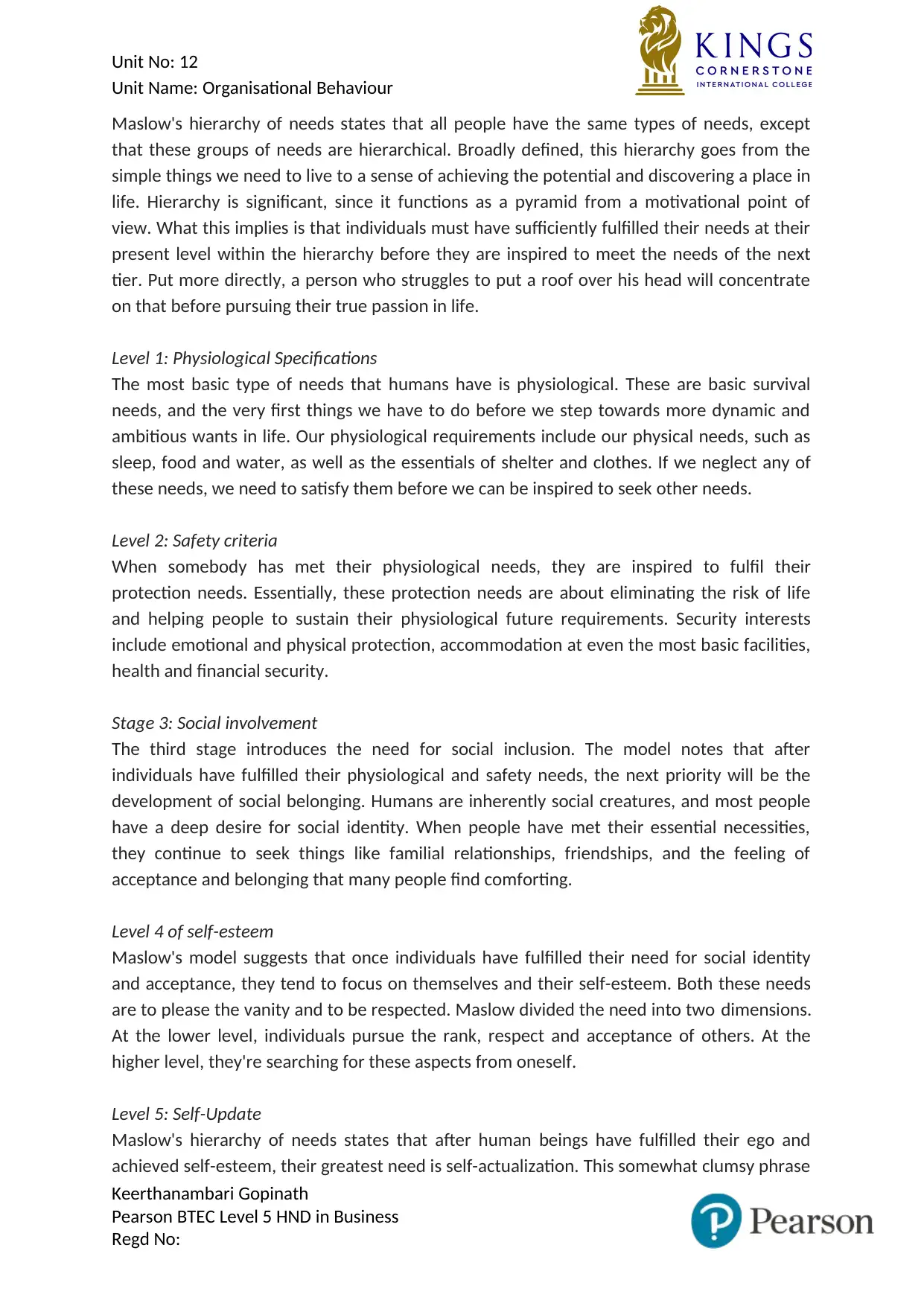
Unit No: 12
Unit Name: Organisational Behaviour
Maslow's hierarchy of needs states that all people have the same types of needs, except
that these groups of needs are hierarchical. Broadly defined, this hierarchy goes from the
simple things we need to live to a sense of achieving the potential and discovering a place in
life. Hierarchy is significant, since it functions as a pyramid from a motivational point of
view. What this implies is that individuals must have sufficiently fulfilled their needs at their
present level within the hierarchy before they are inspired to meet the needs of the next
tier. Put more directly, a person who struggles to put a roof over his head will concentrate
on that before pursuing their true passion in life.
Level 1: Physiological Specifications
The most basic type of needs that humans have is physiological. These are basic survival
needs, and the very first things we have to do before we step towards more dynamic and
ambitious wants in life. Our physiological requirements include our physical needs, such as
sleep, food and water, as well as the essentials of shelter and clothes. If we neglect any of
these needs, we need to satisfy them before we can be inspired to seek other needs.
Level 2: Safety criteria
When somebody has met their physiological needs, they are inspired to fulfil their
protection needs. Essentially, these protection needs are about eliminating the risk of life
and helping people to sustain their physiological future requirements. Security interests
include emotional and physical protection, accommodation at even the most basic facilities,
health and financial security.
Stage 3: Social involvement
The third stage introduces the need for social inclusion. The model notes that after
individuals have fulfilled their physiological and safety needs, the next priority will be the
development of social belonging. Humans are inherently social creatures, and most people
have a deep desire for social identity. When people have met their essential necessities,
they continue to seek things like familial relationships, friendships, and the feeling of
acceptance and belonging that many people find comforting.
Level 4 of self-esteem
Maslow's model suggests that once individuals have fulfilled their need for social identity
and acceptance, they tend to focus on themselves and their self-esteem. Both these needs
are to please the vanity and to be respected. Maslow divided the need into two dimensions.
At the lower level, individuals pursue the rank, respect and acceptance of others. At the
higher level, they're searching for these aspects from oneself.
Level 5: Self-Update
Maslow's hierarchy of needs states that after human beings have fulfilled their ego and
achieved self-esteem, their greatest need is self-actualization. This somewhat clumsy phrase
Keerthanambari Gopinath
Pearson BTEC Level 5 HND in Business
Regd No:
Unit Name: Organisational Behaviour
Maslow's hierarchy of needs states that all people have the same types of needs, except
that these groups of needs are hierarchical. Broadly defined, this hierarchy goes from the
simple things we need to live to a sense of achieving the potential and discovering a place in
life. Hierarchy is significant, since it functions as a pyramid from a motivational point of
view. What this implies is that individuals must have sufficiently fulfilled their needs at their
present level within the hierarchy before they are inspired to meet the needs of the next
tier. Put more directly, a person who struggles to put a roof over his head will concentrate
on that before pursuing their true passion in life.
Level 1: Physiological Specifications
The most basic type of needs that humans have is physiological. These are basic survival
needs, and the very first things we have to do before we step towards more dynamic and
ambitious wants in life. Our physiological requirements include our physical needs, such as
sleep, food and water, as well as the essentials of shelter and clothes. If we neglect any of
these needs, we need to satisfy them before we can be inspired to seek other needs.
Level 2: Safety criteria
When somebody has met their physiological needs, they are inspired to fulfil their
protection needs. Essentially, these protection needs are about eliminating the risk of life
and helping people to sustain their physiological future requirements. Security interests
include emotional and physical protection, accommodation at even the most basic facilities,
health and financial security.
Stage 3: Social involvement
The third stage introduces the need for social inclusion. The model notes that after
individuals have fulfilled their physiological and safety needs, the next priority will be the
development of social belonging. Humans are inherently social creatures, and most people
have a deep desire for social identity. When people have met their essential necessities,
they continue to seek things like familial relationships, friendships, and the feeling of
acceptance and belonging that many people find comforting.
Level 4 of self-esteem
Maslow's model suggests that once individuals have fulfilled their need for social identity
and acceptance, they tend to focus on themselves and their self-esteem. Both these needs
are to please the vanity and to be respected. Maslow divided the need into two dimensions.
At the lower level, individuals pursue the rank, respect and acceptance of others. At the
higher level, they're searching for these aspects from oneself.
Level 5: Self-Update
Maslow's hierarchy of needs states that after human beings have fulfilled their ego and
achieved self-esteem, their greatest need is self-actualization. This somewhat clumsy phrase
Keerthanambari Gopinath
Pearson BTEC Level 5 HND in Business
Regd No:
⊘ This is a preview!⊘
Do you want full access?
Subscribe today to unlock all pages.

Trusted by 1+ million students worldwide
1 out of 33
Related Documents
Your All-in-One AI-Powered Toolkit for Academic Success.
+13062052269
info@desklib.com
Available 24*7 on WhatsApp / Email
![[object Object]](/_next/static/media/star-bottom.7253800d.svg)
Unlock your academic potential
Copyright © 2020–2025 A2Z Services. All Rights Reserved. Developed and managed by ZUCOL.





